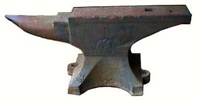Anvil
Origin
Middle English anfilt, from Old English; akin to Old High German anafalz anvil; akin to Latin pellere to beat
Definitions
- 1: a heavy usually steel-faced iron block on which metal is shaped (as by hand hammering)
- 2: incus
- 3: the anvil–shaped top of a cumulonimbus
Description
An anvil is a basic tool, a block with a hard surface on which another object is struck. The block is as massive as is practical, because the higher the inertia of the anvil, the more efficiently it causes the energy of the striking tool to be transferred to the work piece. In most cases the anvil is used as a forging tool. Before the advent of modern welding technology, it was a primary tool of metal workers.
The great majority of modern anvils are made from steel, as well as cast iron or a combination of iron and steel.
Because anvils are very ancient tools and were at one time very commonplace, they have acquired symbolic meaning beyond their use as utilitarian objects.
- Surface
The primary work surface of the anvil is known as the face. It is generally made of hardened steel and should be flat and smooth with rounded edges for most work. Any marks on the face will be transferred to the work. Also, sharp edges tend to cut into the metal being worked and may cause cracks to form in the workpiece. The face is hardened and tempered to resist the blows of the smith's hammer so the anvil face does not deform under repeated use. A hard anvil face also reduces the amount of force lost in each hammer blow. Hammers tools and work pieces of hardened steel should never directly strike the anvil face with full force, as they may damage it, this can result in chipping or deforming of the anvil face.
- Horn
The horn of the anvil is a conical projection used to form various round shapes, and is generally unhardened steel or iron. The horn is used mostly in bending operations. It also is used by some smiths as an aid in "drawing down" stock, (making it longer and thinner). Some anvils, mainly European, are made with two horns, one square and one round. Also, some anvils are made with side horns or clips for specialized work.
- Table
The table, is that area of the anvil between the "horn" and the "face". It is soft and is used for cutting; its purpose is to prevent damaging the steel face of the anvil by conducting such operations there and so as not to damage the cutting edge of the chisel, many smiths shun this practice, as it will damage the anvil over time.
- Hardie hole
The hardie hole is a square hole into which specialized forming and cutting tools, called hardie tools, are placed. It is also used in punching and bending operations.
- Pritchel hole
The pritchel hole is a small round hole that is present on most modern anvils. Some anvils have more than one. It is used mostly for punching. At times, smiths will fit a second tool to this hole to allow the smith more flexibility when using more than one anvil tool.[1]
Quote
Civilization was literally forged out between the anvil of necessity and the hammers of fear. (66:5.13)
